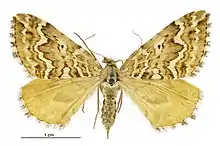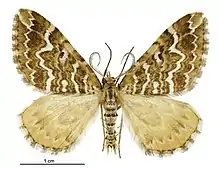| Asaphodes clarata | |
|---|---|
 | |
| Female | |
 | |
| Male | |
| Scientific classification | |
| Domain: | Eukaryota |
| Kingdom: | Animalia |
| Phylum: | Arthropoda |
| Class: | Insecta |
| Order: | Lepidoptera |
| Family: | Geometridae |
| Genus: | Asaphodes |
| Species: | A. clarata |
| Binomial name | |
| Asaphodes clarata (Walker, 1862) | |
| Synonyms[1] | |
| |
Asaphodes clarata is a species of moth in the family Geometridae. This species is endemic to New Zealand and has been found on the North and South Islands. The species inhabits open grassy areas, including tussock grasslands, in montane habitat. The larvae feed on the leaves of Ranunculus species. The adult moths are day flying and are on the wing from December to February and have been shown to pollinate Celmisia laricifolia and Hebe pinguifolia.
Taxonomy
This species was described by Francis Walker in 1862 as Larentia clarata using material collected in Waikouaiti in Otago.[1][2] Meyrick discussed this species under that name in both 1883 and 1884 and also synonymised Cidaria pyramaria with this species.[3][4] George Hudson also discussed and illustrated this species under the name Xanthorhoe clarata in both 1898 and in 1928.[5][6] In 1971 J. S. Dugdale confirmed the placement of this species in the genus Asaphodes.[7] In 1988 Dugdale confirmed this placement in his catalogue of New Zealand Lepidoptera.[1] The female holotype specimen, collected at Waikouaiti, is held at the Natural History Museum, London.[1]
Description

.jpg.webp)
Hudson described the species as follows:
The expansion of the wings of the male is 1+1⁄2 inches, of the female 1+3⁄8 inches. The species differs from the preceding in the following respects : The ground colour of the forewings is brighter, the markings are less oblique and much more jagged ; the large white central band is often broken up into several distinct oval patches, the costal edge is very slightly shaded with brown, and the transverse lines do not disappear before reaching the costa. The hind-wings are bright ochreous. The cilia of all the wings are white, strongly barred with yellowish-brown.[5]
This species varies in the colour intensity and the width of the white markings of its forewings.[6]
Distribution
A. clarata is endemic to New Zealand.[8][9] It is an upland species and occurs on the tussock covered slopes of ranges in both the North and South Islands.[10] It has been recorded as being present in Otago and in Canterbury.[11][12]
Behaviour

The adults of this species are on the wing from November to March.[6] It is a day flying moth.[12]
Habitat and host species
This species frequents open grassy patches in montane habitat.[5] Larvae of this species feed on the foliage of Ranunculus species.[13][14] The adult moth has been shown to pollinate Celmisia laricifolia and Hebe pinguifolia.[15]
References
- 1 2 3 4 Dugdale, J. S. (1988). "Lepidoptera - annotated catalogue, and keys to family-group taxa" (PDF). Fauna of New Zealand. 14: 173. Archived from the original (PDF) on 27 January 2019. Retrieved 10 July 2018.
- ↑ Walker, Francis (1862). "Geometrites (continued)". List of the Specimens of Lepidopterous Insects in the Collection of the British Museum. XXIV: 1021–1280 – via Biodiversity Heritage Library.
- ↑ Edward Meyrick (September 1883). "Descriptions of New Zealand Micro-Lepidoptera.—III.—Oecophoridae". New Zealand Journal of Science. 1: 528. Wikidata Q106368126.
- ↑ Edward Meyrick (May 1884). "A Monograph of the New Zealand Geometrina". Transactions and Proceedings of the New Zealand Institute. 16: 79. ISSN 1176-6158. Wikidata Q109615359.
- 1 2 3 Hudson, George Vernon (1898). New Zealand moths and butterflies (Macro-lepidoptera). London: West, Newman & Co. pp. 61–62. doi:10.5962/bhl.title.7912.
- 1 2 3 George Vernon Hudson (1928), The butterflies and moths of New Zealand, Illustrator: George Hudson, Wellington: Ferguson and Osborn Limited, pp. 118–119, LCCN 88133764, OCLC 25449322, Wikidata Q58593286
- ↑ Dugdale, J. S. (10 November 1971). "Entomology of the Aucklands and other islands south of New Zealand: Lepidoptera, excluding non-crambine Pyralidae" (PDF). Pacific Insects Monographs. 27: 55–172. ISSN 0078-7515. Wikidata Q64006453.
- ↑ Gordon, Dennis P., ed. (2010). New Zealand inventory of biodiversity: Kingdom animalia: chaetognatha, ecdysozoa, ichnofossils. Vol. 2. p. 459. ISBN 978-1-877257-93-3. OCLC 973607714. OL 25288394M. Wikidata Q45922947.
- ↑ "Asaphodes clarata (Walker, 1862)". www.nzor.org.nz. Landcare Research New Zealand Ltd. Retrieved 2018-07-10.
- ↑ Gaskin, D. E. (1966). The butterflies and common moths of New Zealand. Christchurch: Whitcombe and Tombs Ltd. p. 138. OCLC 4624894.
- ↑ Patrick, B. (January 1982). "Lepidoptera of Danseys Pass, Otago" (PDF). New Zealand Entomologist. 7 (3): 332–336. doi:10.1080/00779962.1982.9722418. Archived from the original (PDF) on 2011-09-29. Retrieved 10 July 2018.
- 1 2 White, E. G. (1991). "The changing abundance of moths in a tussock grassland, 1962-1989, and 50-to 70-year trends". New Zealand Journal of Ecology. 15 (1): 5–22. CiteSeerX 10.1.1.411.5259.
- ↑ "PlantSynz - Invertebrate herbivore biodiversity assessment tool: Database". plant-synz.landcareresearch.co.nz. Retrieved 2018-07-10.
- ↑ Brian H. Patrick (April 2000). Conservation status of two rare New Zealand geometrid moths (PDF). Vol. 145. pp. 1–21. ISBN 0-478-21946-6. ISSN 1173-2946. Wikidata Q109608608.
{{cite book}}:|journal=ignored (help) - ↑ Primack, Richard B. (July 1983). "Insect pollination in the New Zealand mountain flora". New Zealand Journal of Botany. 21 (3): 317–333. doi:10.1080/0028825X.1983.10428561.